- Bad Naturalist Newsletter
- Posts
- Mountain Goated
Mountain Goated
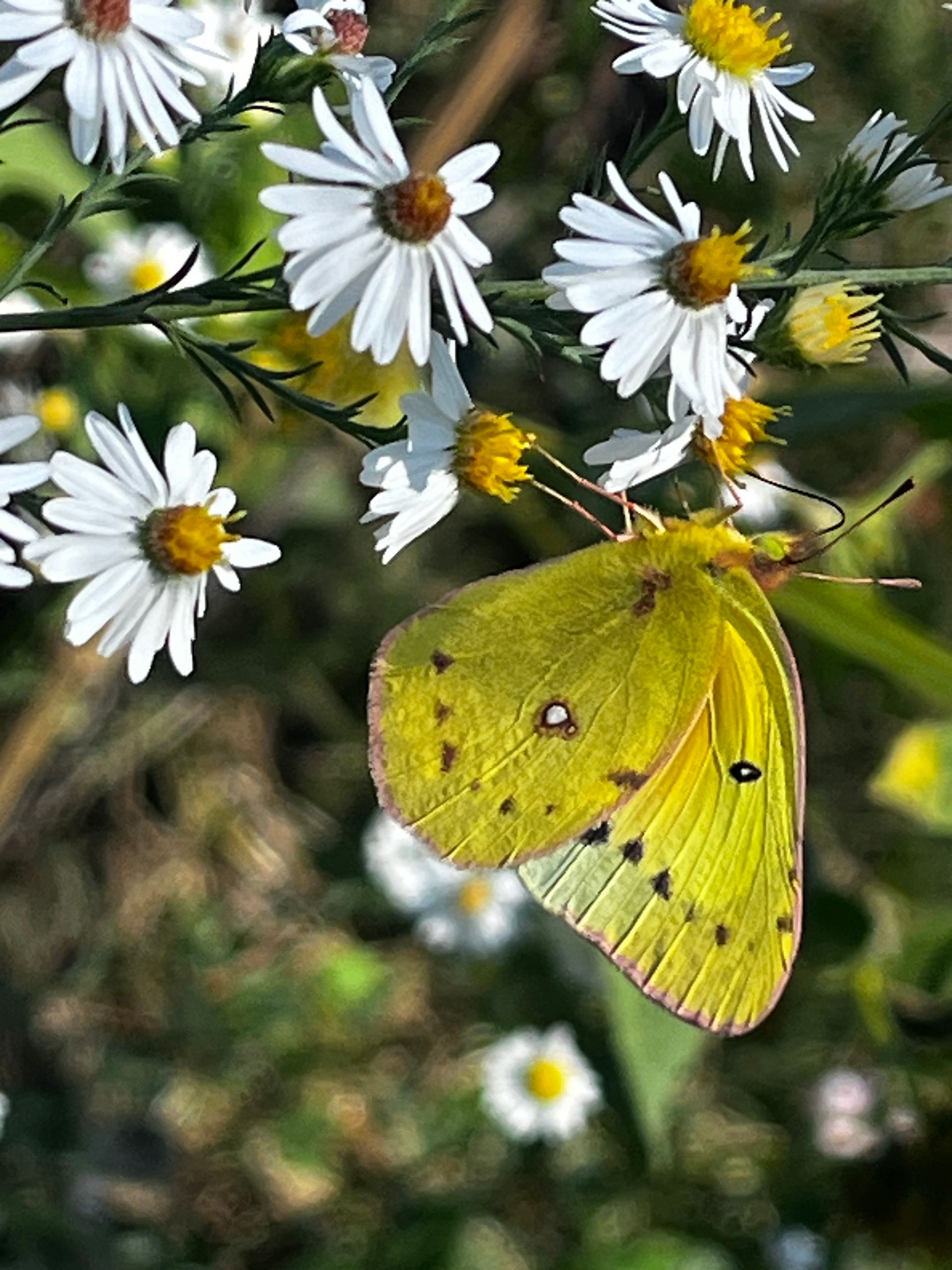
Geek out with me about critters and plants on a mountaintop in Virginia. I’ll share what I’m learning as I try to bring native plants back on 200 acres of old farmland and tell stories from my encounters on the mountain.
Want to subscribe? (It’s free!)
Want to read it first? (I don’t blame you.)
In this issue
Field notes: Goats! Goats! Goats! (and Sheep!)
Signs of life: Pollinator parade
Recommended reading
Book news: Prescribed fire panel and more
The Official Mountain Poodle
I’ve written a book about what I’m doing and what I’m discovering here on the mountain…
BAD NATURALIST: One Woman’s Ecological Education on a Wild Virginia Mountaintop
Field notes
Goats! Goats! Goats! or, Eating the evidence

As part of my “try (almost) everything” approach to managing invasive plants on the mountain, I was excited to bring goats to the mountain. Throughout late summer, I lamented the resurgence of mile-a-minute vine here. Earlier in the season, the vine was hidden beneath dense growth. When it finally burst into the open in July, it was too late to spray it without collateral damage to a host of other plants and anything else living in the fields. Goats, as I mentioned last month, are known as effective weed-eaters (and everything-else eaters). And a more desirable approach to knocking down noxious weeds than using toxic chemicals.
When the animals arrived, the mile-a-minute seeds were already starting to ripen. If nothing stopped them, it would mean another year’s worth of the plant’s seeds added to the seedbank. But any seeds a goat ate would be pulverized in its digestive tract. My hope was that the animals would arrest the spread of the vine this year and reduce the number of viable seeds that could grow next year.
The herd of about three dozen included a mix of male sheep and goats (some of them were fixed, known as wethers)—and a TOTALLY ADORBS guardian llama named Elijah. Why sheep AND goats? The goats climb fearlessly, standing on hind legs and grabbing anything they can get to, which for the larger goats means anything up to 7 feet high, whereas the sheep focus on plants that are closer to the ground, within easy reach. Between them, they’d cover all the bases. The larger goats were Nubians (dairy goats) and the smaller ones were Boer goats (meat goats). The sheep were a Katahdin/St. Croix mix—known as hair sheep because they shed their coats in spring and never need shearing. Over the course of three weeks, they would eat their way through three adjacent fields. A movable polywire electric fence kept them in, and, along with Elijah, discouraged predators.

Elijah the guardian llama assesses me
Whenever I approached the fence, Elijah met me there and stared at me imperiously. Where do you think you’re going? (I’m not anthropomorphizing or anything…)
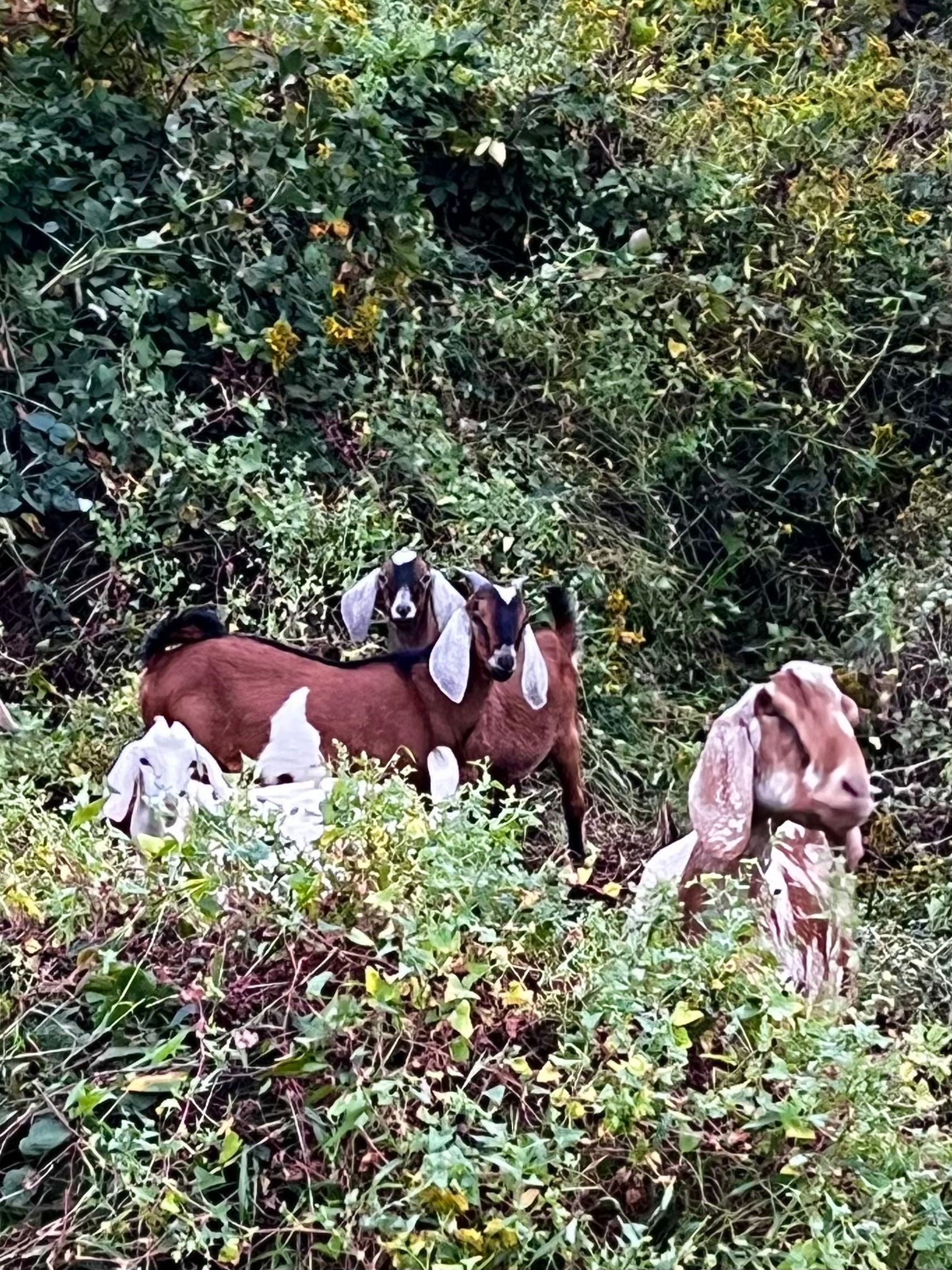
“Before”: goats surrounded by overgrown mile-a-minute vine.

Everywhere Elijah went, the lambs were sure to go…
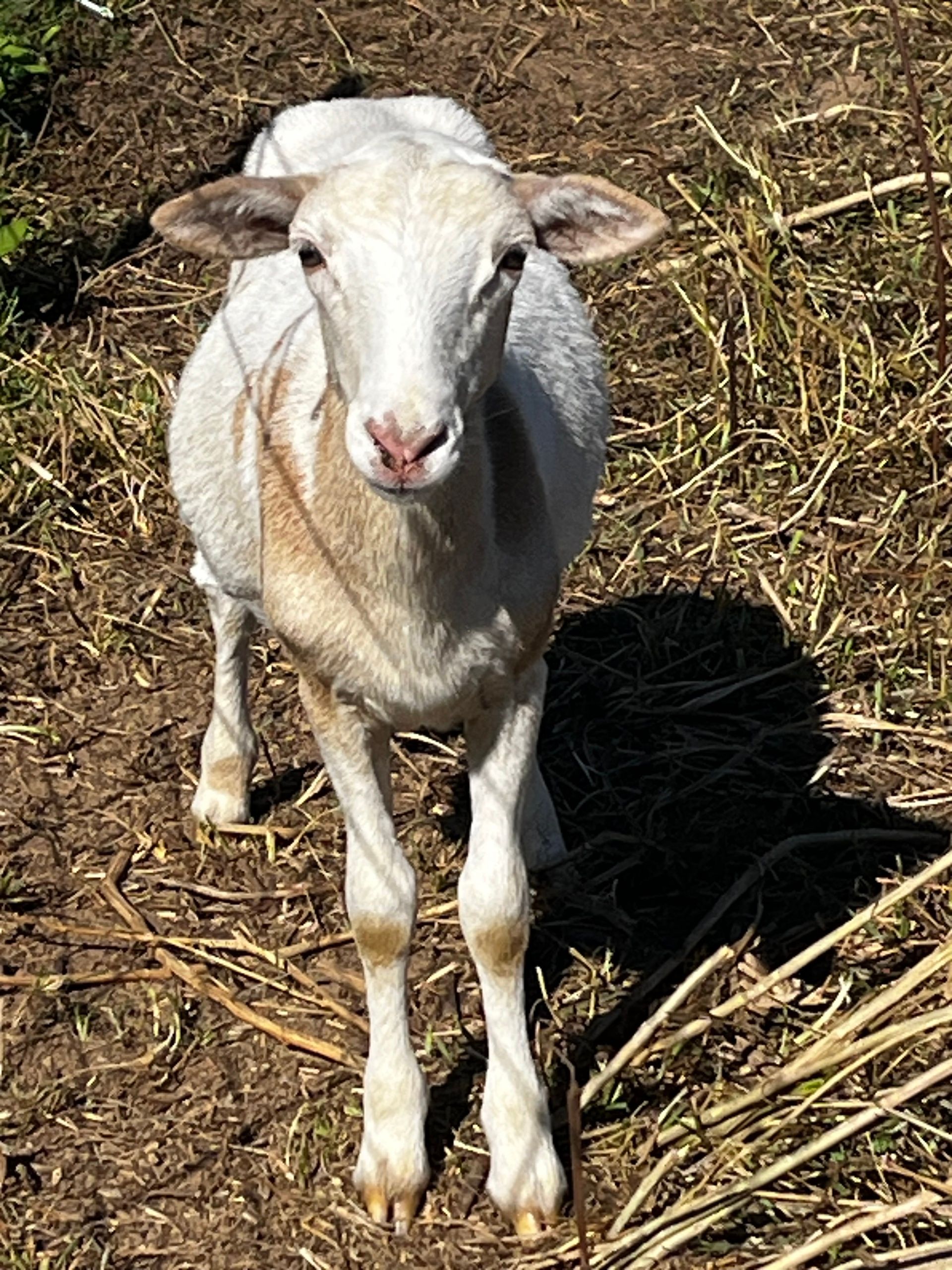
The animals immediately set to work not only on the leaves but also the seeds that were turning from green to purple on the vines. In the aftermath, random clumps of vegetation dot the fields, but the eating machines, er, goats, were pretty thorough, and I’m optimistic about the outcome.
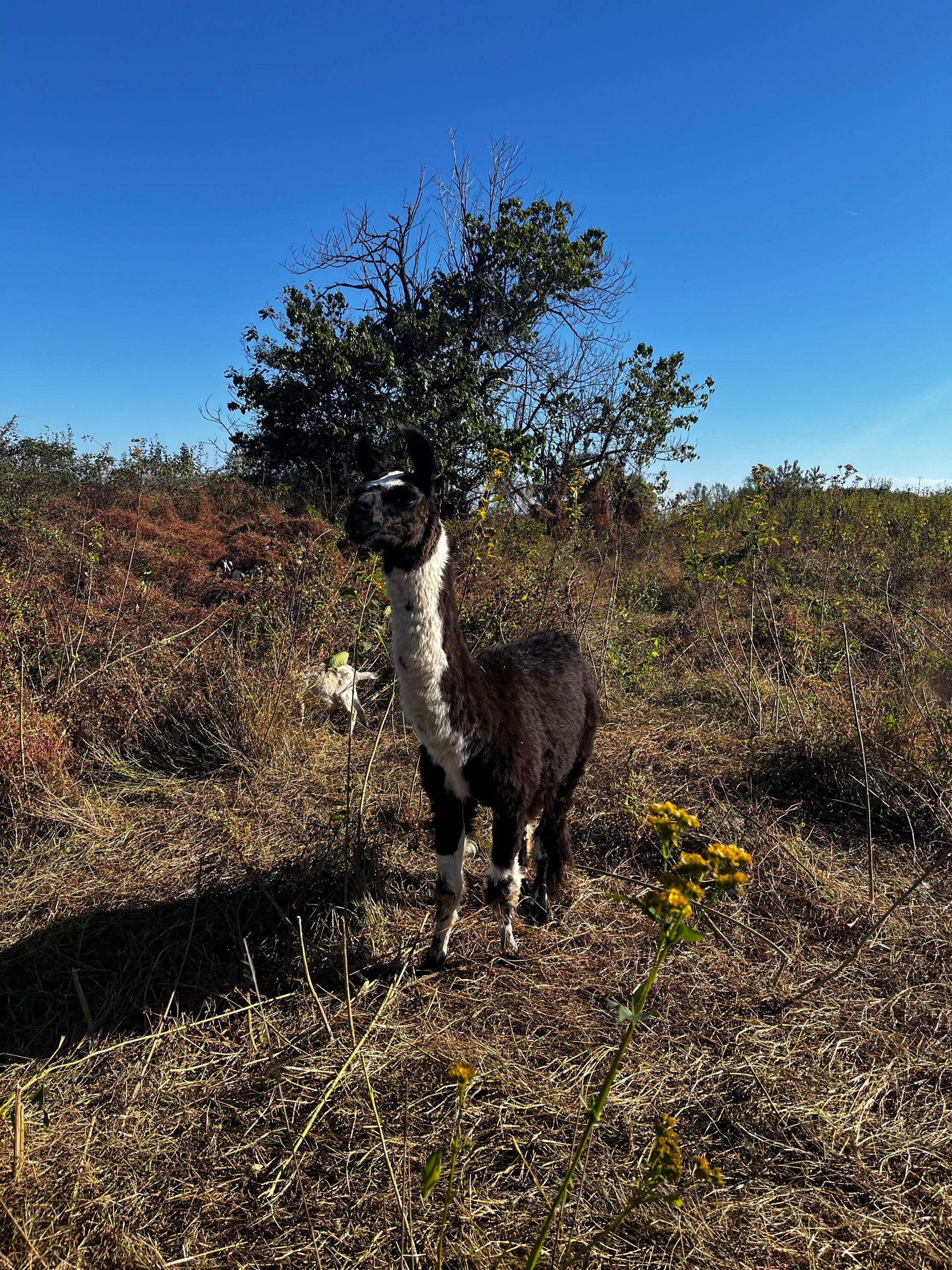
Aftermath: what a field looks like when the animals are nearly ready to move on.
The next step is to burn these fields as part of a larger prescribed burn, tentatively scheduled for November. Whether that happens will depend on the weather and the availability of staff at the state Department of Forestry. Native plants here evolved with fire, and burning helps them to grow more successfully and produce more seeds, which helps make the meadow less vulnerable to invasive plants. Burning will also eliminate the many built-up layers of dry, dead plant matter that can suppress native plant growth. If the fields are burned, it will be far easier to spot—and either treat or “eat”—the undesirable vines when they grow back in late spring.
Signs of Life
Pollinators on parade
I didn’t realize that daisy fleabane can flower in both spring and fall. Like so many native plants, it’s often seen as a “weed,” but it’s really an important pollinator plant. Daisy fleabane is in the aster family, and this year it attracted monarchs in droves. (Monarchs visit asters for their nectar.) In fact, this has been the biggest year on the mountain for monarchs since my time here began—I recently spotted more than six migrating monarchs on a single daisy fleabane plant.
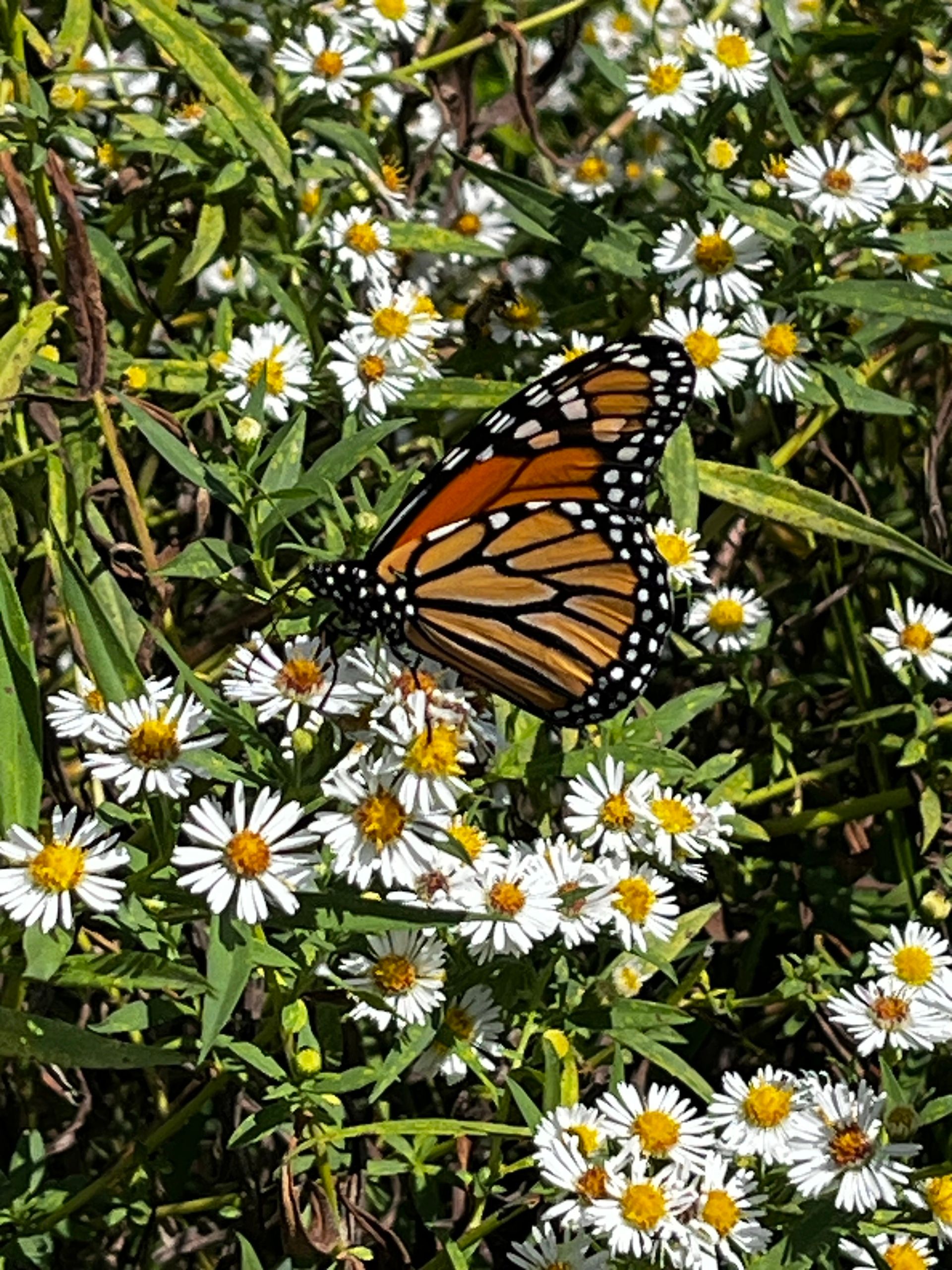
Migratory monarch on daisy fleabane
Buckeyes, sulphurs, skippers, zebra swallowtail, and a few varieties of hoverfly visited the fall fleabane in large numbers. Coreopsis tempted a variegated fritillary on its way to the fleabane party. Daisy fleabane also self-pollinates, so all of these pollinator visits are a big bonus, and I’m guessing I’ll see even more daisy fleabane here next year.
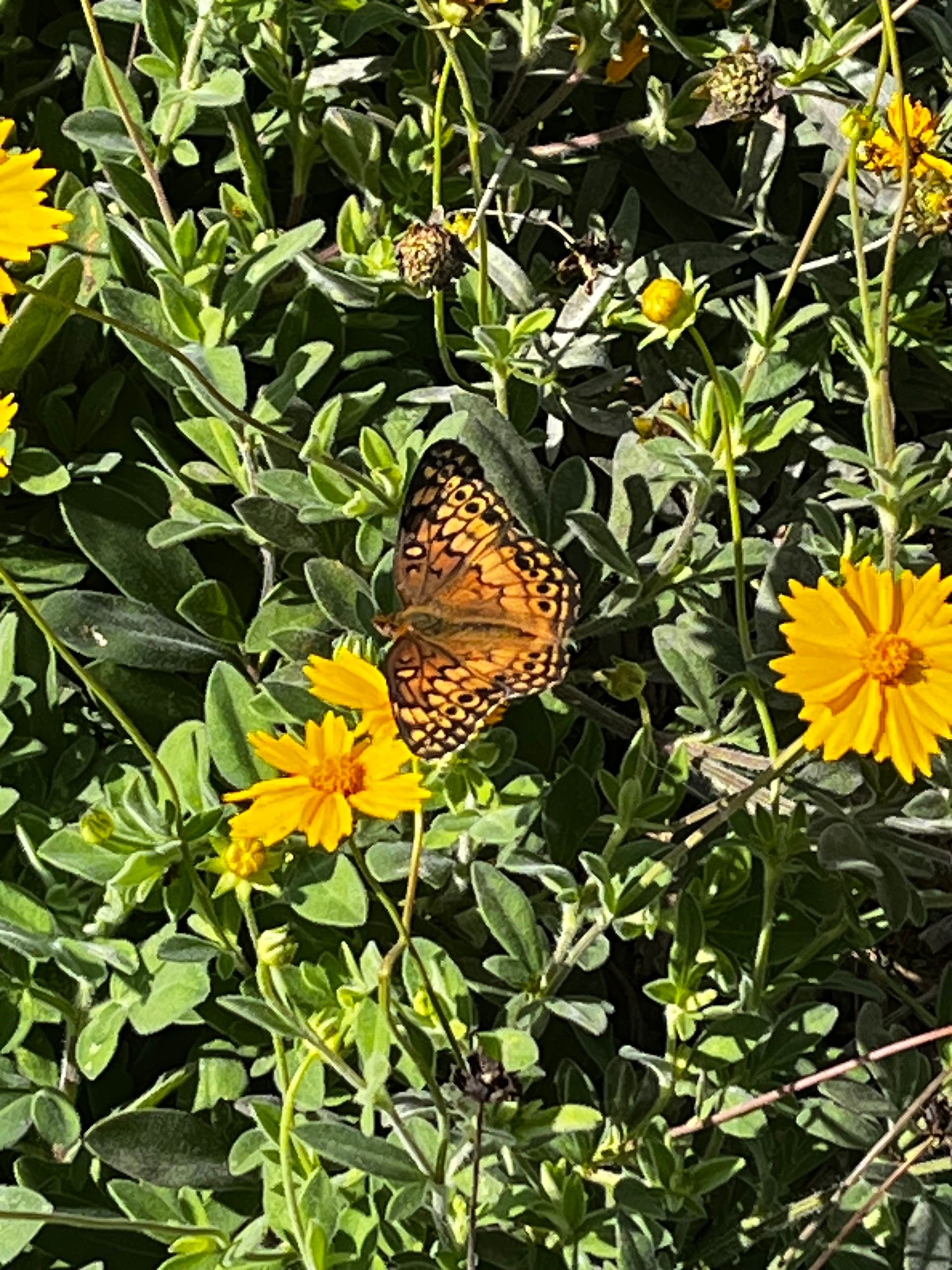
variegated fritillary on coreopsis
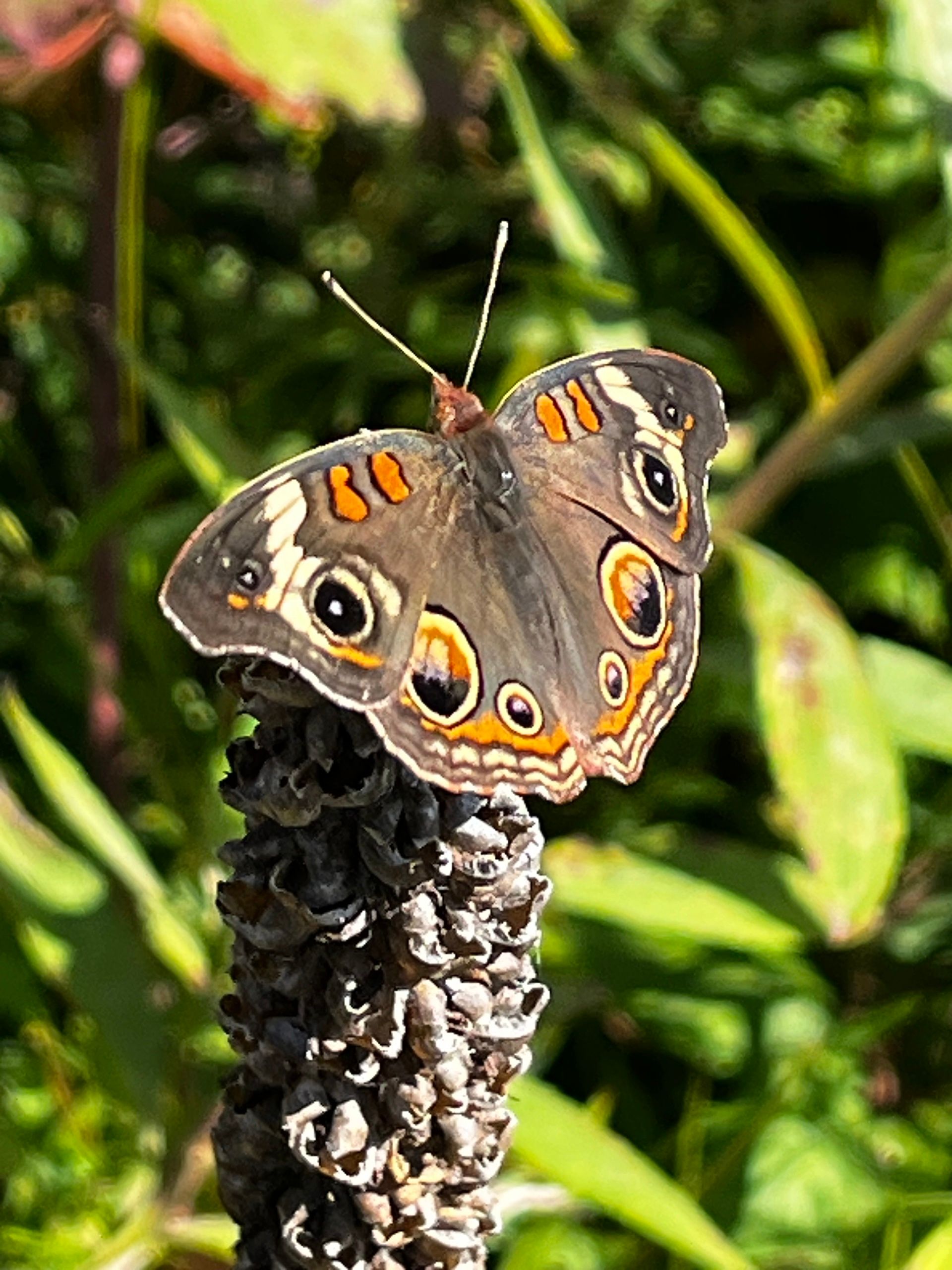
Buckeye posing on common mullein in between daisy fleabane visits.
Common mullein is yet another invasive weed. It was introduced in the 1700s in Virginia, apparently for use in poisoning fish. Although I’d rather not have it here at all, it’s not that profuse (yet). And it was the only place the buckeye would stand still long enough for me to take a photo.
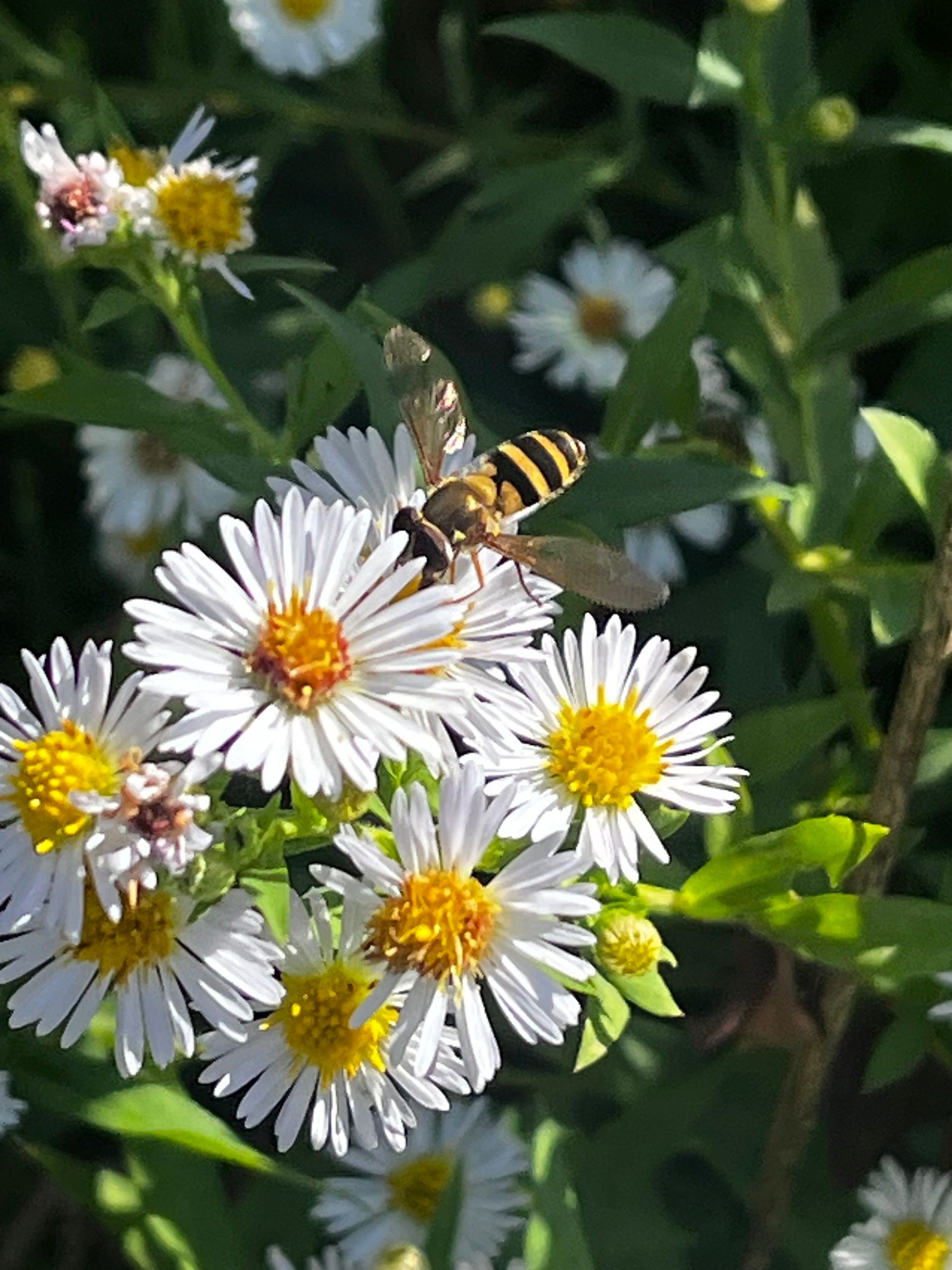
black-horned smoothtail hoverfly on daisy fleabane
Hoverflies like the black-horned smoothtail are important pollinators, and they’re easily mistaken for bees. That’s camouflage. If you’re not sure, check out the eyes: they have fly eyes; and the wings—they have a single pair of wings, unlike bees, which have double wings. Hoverflies don’t sting, so don’t worry if they try to land on you.
Recommended reading
Charlotte Lorick, a plant expert who was a great help to me in my native meadow quest on the mountain, now has her own newsletter, and (surprise!) it’s all about plants! It’s called Forgotten Flora: Curated content for the thoughtful land steward & the botanically curious.
When I met her, Charlotte was with the Smithsonian’s Virginia Working Landscapes. She is now managing a massive ecological restoration as head of biodiversity conservation at Oak Spring Garden Foundation (OSGF), the former estate of Bunny Mellon in Virginia. OSGF is devoted to promoting research on and interest in plants.
The latest edition of Forgotten Flora is about Charlotte’s work transforming a hay field at Oak Spring into a native meadow—no wonder I’m a devoted reader!

Forgotten Flora newsletter, by Charlotte Lorick
Book news
In October, I spoke on a panel about prescribed fire for Blue Ridge Prism, along with Jean Lorber, a conservation scientist with The Nature Conservancy, and Adam Coates, a professor of fire ecology at Virginia Tech. It was a fascinating conversation—I learned a lot from my co-panelists—and you can watch the recording here. (It’s free.)

October events
In addition to the Blue Ridge Prism panel, this month I enjoyed visiting book clubs, a master gardener group, and a women’s club. At the end of the month, I’ll be giving a talk at a public garden in Fairfax County, VA:
Green Spring Gardens, in-person talk and Q&A followed by book signing. Alexandria, VA. Saturday, October 25, 11am.
New events coming in early 2026!
Looking ahead, here are a few of the events already scheduled for Jan/Feb. I’ll share more details as I have them. Please come out if you’re in the area, or consider attending a remote event!
Revalation Vineyards in Madison, VA; Book World Meets Wine World, Jan. 23.
Wing Haven Gardens in Charlotte, NC, Jan. 29.
Haverford College Arboretum, with Narberth Bookstore, Haverford, PA, Feb. 10.
American Horticultural Society, remote talk, Feb. 12.
Check my website event page, or my Instagram or Bluesky feeds for details about events, and for more interviews, podcasts, and features. If you don’t see your city or town on this list, please reach out, and I’ll see what I can do to get there!
Bad Naturalist is available wherever books are sold in stores and online, in hardcover, e-book, and audiobook formats. You can sample the audiobook here.
A special request
If you read the book in any format (and if you enjoyed it!), please post a review on the Amazon book page! It helps!
Tell me where you are and what you see this month in a park near where you live, or in your own yard or window box. Send me a photo if you like.
And don’t forget to tell me about your favorite nature-related book or podcast.
The Official Mountain Poodle
Just a poodle basking in the glow of the late-day sun and sniffing the air for rabbits.
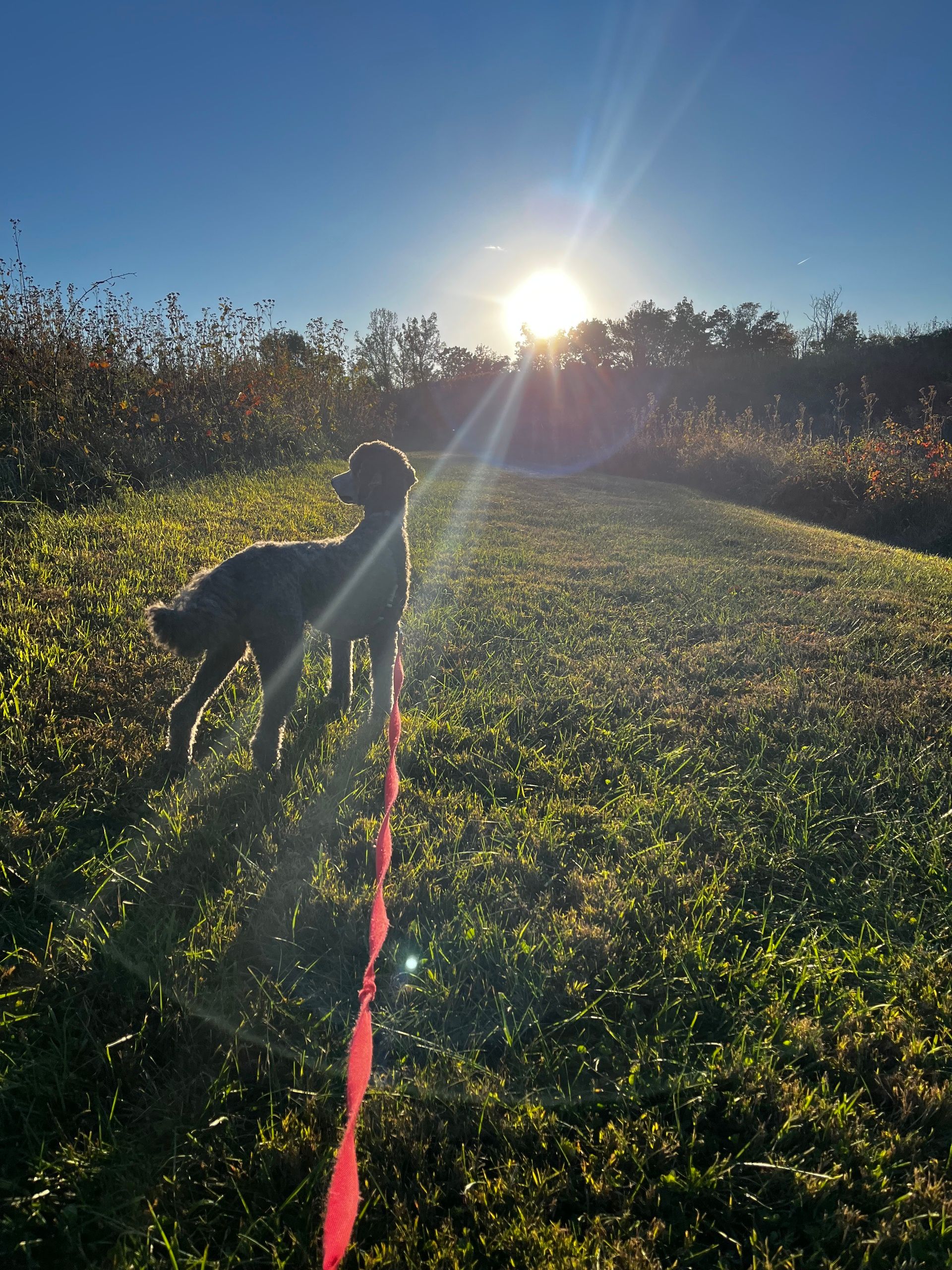
Now’s a good time to subscribe for more mountain discoveries, book news, and the requisite poodle photos.
Thanks for joining me on the mountain!
Until next month—
Paula W.
P.S. The cover photo this month is a close-up of a sulphur butterfly on daisy fleabane.
Bad Naturalist: One Woman’s Ecological Education on a Wild Virginia Mountaintop
Now available in hardcover, audiobook, and e-book everywhere books are sold!
You can also…
Reply